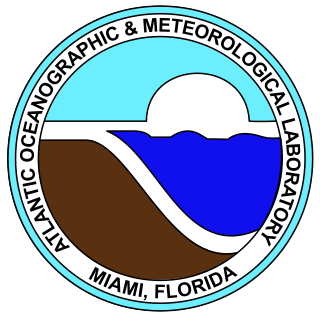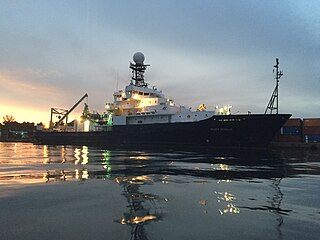The National Ocean Service (NOS) is an office within the U.S. Department of Commerce, National Oceanic and Atmospheric Administration (NOAA). It is responsible for preserving and enhancing the nation's coastal resources and ecosystems along approximately 95,000 miles (153,000 km) of shoreline, that is bordering 3,500,000 square miles (9,100,000 km2) of coastal, Great Lakes and ocean waters. Its mission is to "provide science-based solutions through collaborative partnerships to address evolving economic, environmental, and social pressures on our oceans and coasts." The office works with partnered agencies to ensure that ocean and coastal areas are safe, healthy, and productive. It`s projects focus on working to ensure safe and efficient marine transportation, promoting the protection of coastal communities, conserving marine and coastal places. It employs 1,700 scientists, natural resource managers, and specialists in many different fields. The National Ocean Service was previously known as the National Ocean Survey until it was renamed in 1983.

Argo is an international programme for researching the ocean. It uses profiling floats to observe temperature, salinity and currents. Recently it has observed bio-optical properties in the Earth's oceans. It has been operating since the early 2000s. The real-time data it provides support climate and oceanographic research. A special research interest is to quantify the ocean heat content (OHC). The Argo fleet consists of almost 4000 drifting "Argo floats" deployed worldwide. Each float weighs 20–30 kg. In most cases probes drift at a depth of 1000 metres. Experts call this the parking depth. Every 10 days, by changing their buoyancy, they dive to a depth of 2000 metres and then move to the sea-surface. As they move they measure conductivity and temperature profiles as well as pressure. Scientists calculate salinity and density from these measurements. Seawater density is important in determining large-scale motions in the ocean.

A tsunami warning system (TWS) is used to detect tsunamis in advance and issue the warnings to prevent loss of life and damage to property. It is made up of two equally important components: a network of sensors to detect tsunamis and a communications infrastructure to issue timely alarms to permit evacuation of the coastal areas. There are two distinct types of tsunami warning systems: international and regional. When operating, seismic alerts are used to instigate the watches and warnings; then, data from observed sea level height are used to verify the existence of a tsunami. Other systems have been proposed to augment the warning procedures; for example, it has been suggested that the duration and frequency content of t-wave energy is indicative of an earthquake's tsunami potential.

A tide gauge is a device for measuring the change in sea level relative to a vertical datum. It is also known as a mareograph, marigraph, sea-level recorder and limnimeter. When applied to freshwater continental water bodies, the instrument may also be called a limnimeter.

An autonomous underwater vehicle (AUV) is a robot that travels underwater without requiring continuous input from an operator. AUVs constitute part of a larger group of undersea systems known as unmanned underwater vehicles, a classification that includes non-autonomous remotely operated underwater vehicles (ROVs) – controlled and powered from the surface by an operator/pilot via an umbilical or using remote control. In military applications an AUV is more often referred to as an unmanned undersea vehicle (UUV). Underwater gliders are a subclass of AUVs.

The Atlantic Oceanographic and Meteorological Laboratory (AOML), a federal research laboratory, is part of the National Oceanic and Atmospheric Administration's (NOAA) Office of Oceanic and Atmospheric Research (OAR), located in Miami in the United States. AOML's research spans tropical cyclone and hurricanes, coastal ecosystems, oceans and human health, climate studies, global carbon systems, and ocean observations. It is one of seven NOAA Research Laboratories (RLs).

An underwater glider is a type of autonomous underwater vehicle (AUV) that employs variable-buoyancy propulsion instead of traditional propellers or thrusters. It employs variable buoyancy in a similar way to a profiling float, but unlike a float, which can move only up and down, an underwater glider is fitted with hydrofoils that allow it to glide forward while descending through the water. At a certain depth, the glider switches to positive buoyancy to climb back up and forward, and the cycle is then repeated.

R/V Roger Revelle is a Thomas G. Thompson-class oceanographic research ship operated by Scripps Institution of Oceanography under charter agreement with Office of Naval Research as part of the University-National Oceanographic Laboratory System (UNOLS) fleet. The ship is named after Roger Randall Dougan Revelle, who was essential to the incorporation of Scripps into the University of California San Diego.

USNS Indomitable (T-AGOS-7) was a United States Navy Stalwart-class ocean surveillance ship in service from 1985 to 2002. From 2003 until 18 June 2014, she was in commission in the National Oceanic and Atmospheric Administration (NOAA) as the oceanographic research ship NOAAS McArthur II. As of 2018 it serves as a mother ship now named the Deep Submersible Support Vessel (DSSV) Pressure Drop for the crewed deep-ocean research submersible DSV Limiting Factor.

USNS Relentless (T-AGOS-18) was a Stalwart-class modified tactical auxiliary general ocean surveillance ship in service in the United States Navy from 1990 to 1993. Since 1998, she has been in commission in the National Oceanic and Atmospheric Administration (NOAA) fleet as the fisheries research ship NOAAS Gordon Gunter.

Traditionally, areas of tropical cyclone formation are divided into seven basins. These include the north Atlantic Ocean, the eastern and western parts of the northern Pacific Ocean, the southwestern Pacific, the southwestern and southeastern Indian Oceans, and the northern Indian Ocean. The western Pacific is the most active and the north Indian the least active. An average of 86 tropical cyclones of tropical storm intensity form annually worldwide, with 47 reaching hurricane/typhoon strength, and 20 becoming intense tropical cyclones, super typhoons, or major hurricanes.

James Martin Moran was an American car dealer and philanthropist whose net worth of $2.4 billion ranked him 390th on the Forbes 400 at the time of his death.

USS Williamsburg was a US Navy gunboat. A former private yacht, it also served as a presidential yacht from 1945 to 1953.

Wave radar is a type of radar for measuring wind waves. Several instruments based on a variety of different concepts and techniques are available, and these are all often called. This article, gives a brief description of the most common ground-based radar remote sensing techniques.
The following are considered ocean essential climate variables (ECVs) by the Ocean Observations Panel for Climate (OOPC) that are currently feasible with current observational systems.

USS Mobjack (AVP-27/AGP-7) was a motor torpedo boat tender in commission in the United States Navy from 1943 to 1946. She saw service in the Pacific theater during the latter portion of World War II.

Motor Yacht A is a superyacht designed by Philippe Starck and engineered by naval architect Martin Francis. It was built by the Blohm + Voss shipyard at the HDW deepwater facility in Kiel. It was ordered in November 2004, and delivered in 2008 at a rumoured cost of US$300 million. With a length of 119 metres (390 ft) and measuring almost 6,000 tonnes, it is one of the largest motor yachts in the world. It is owned by Russian entrepreneur and industrialist Andrey Melnichenko. To avoid seizure by EU authorities, the yacht has been laid up in the United Arab Emirates since 2022.
The Marine Exchange of Alaska (MXAK) is a nonprofit maritime organization based in Juneau, Alaska. MXAK was founded in 2001 by retired United States Coast Guard Captain Edward Page, who along with Paul Fuhs and others in the maritime community established a Governing Board. The organization was established to broker information, that aids safe, secure, efficient, and environmentally sound maritime operations in Alaska. MXAK's greatest advance in promoting maritime safety has been the establishment, operation and maintenance of an extensive vessel tracking network comprising over 140 Automatic Identification System (AIS) and Marine Safety stations in Alaska, complemented with satellite tracking systems. MXAK also serves the maritime community by assisting vessels, facilities and ports to comply with state and federal environmental, safety, and security regulations, and installing and maintaining weather stations at remote locations across Alaska. The Marine Exchange of Alaska is a presence in local, state, and federal meetings and workshops, advocating for cost effective measures that benefit Alaska and the maritime community.

NOAAS David Starr Jordan (R444)) was an American fisheries research vessel in commission in the National Oceanic and Atmospheric Administration (NOAA) from 1970 to 2010. She previously was in the United States Fish and Wildlife Service's Bureau of Commercial Fisheries fleet from 1966 to 1970 as US FWS David Starr Jordan.

NOAAS Pisces is an American fisheries and oceanographic research vessel in commission in the National Oceanic and Atmospheric Administration (NOAA) fleet since 2009.

















